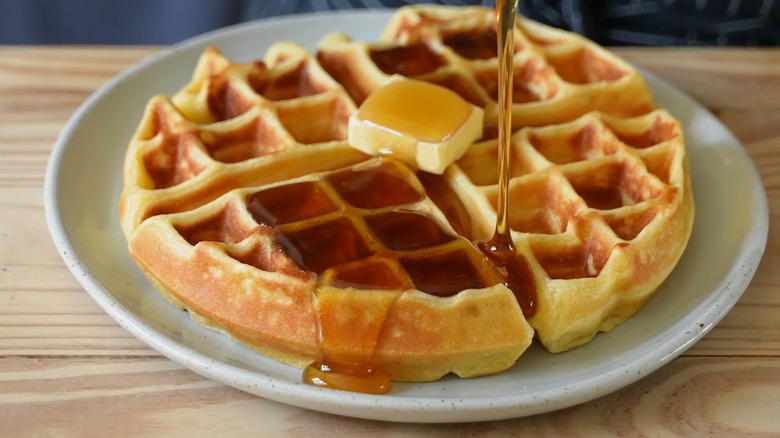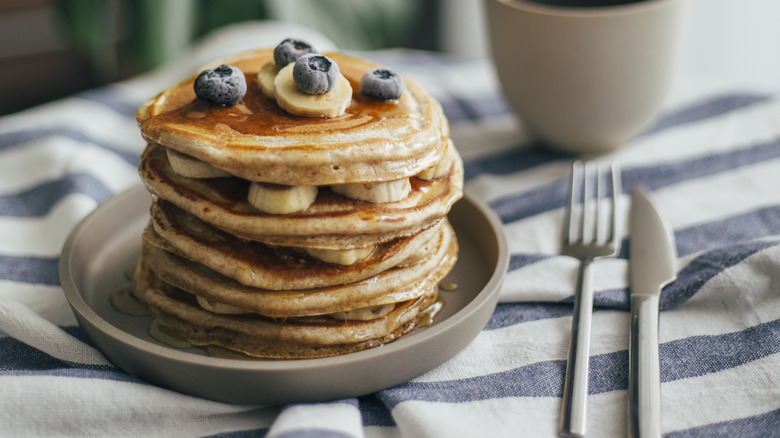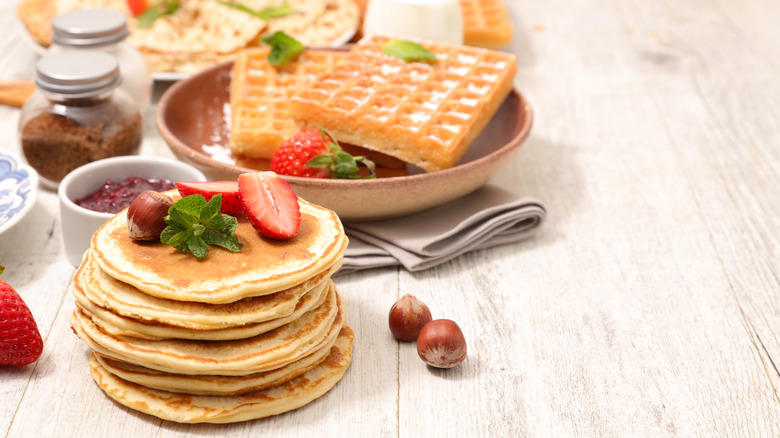Why Pancakes And Waffles Taste Better At A Restaurant Than At Home
Ask any discerning foodie, and they'll tell you: A good roadside diner is a holy institution. For families on road trips or friends craving a 4 a.m. bite, diners are reliable repositories for heaping stacks of pancakes or freshly ironed waffles. Either way, when you see that glowing "World's Best Diner" sign, chances are (if you're like us), you're making an immediate stop to try it out. A lot of establishments proudly display this stately sign, and, at some level, they're all right. Diners rock, and no matter how fluffy your homemade pancakes are (we're sure they're great), diner pancakes and waffles are almost certainly better — and there are a few reasons why.
As for Waffle House, the chain is happy to share that "farm-fresh eggs and rich, creamy half-and-half" are part of its crave-able waffle equation. Not to be outdone, IHOP shares that real buttermilk is a key ingredient in its classic pancakes. Classic, whole ingredients are usually the best starting place for better hotcakes, but it's more and more common to see cheaper fillers like cornstarch and the use of shortening instead of butter. Still, flapjacks and waffles are so simple in terms of ingredients that it's really all about nailing the proportions, which is why many iconic restaurants keep their batter recipes a secret. Even so, not reinventing the wheel is probably the best policy, and sticking with just a supremely hot griddle and un-experimental batters (it's a comfort food after all) is likely how most roadside joints keep their doors open.
It's a diner's job to know more about your pancakes than you do
This is not to discount the value of well-thought-out techniques, which established chains have down to a science. Marie Grimm, IHOP's vice president of culinary innovation, revealed to Delish that to make a killer batter, the wet ingredients should be "ice cold." Using cold eggs, milk, butter, oil, and water prevents the ingredients from prematurely heating the gluten in the flour, which is responsible for creating the springy bounce that IHOP pancake fans love and have come to expect from the chain's short stack.
Another advantage of diners is having better equipment. While the griddles themselves likely vary from one diner chain to the next, diners are pretty much all working with a waffle iron or griddle that's already piping hot. IHOP, for instance, requires its pans to be heated to 350 degrees Fahrenheit and uses Crisco instead of butter to grease them, says Grimm. IHOP also has designated griddles that never cook anything other than pancakes so as not to mess up the flavor, as Jon Kotez, IHOP's senior manager of field operations support, told Restaurant Business. When home cooks make pancakes in their own kitchens, it's a big deal if they whip out a cast iron skillet — forget about taking any temperatures.
Putting the 'we can just make that stuff at home' argument to rest (sorry, mom)
While it's true that, as we mentioned prior, diners do what they do best by not reinventing the wheel, there's a reason why foodies trust diners as the most skilled wheel-makers. An undeniable element of technique is involved in the flipping, timing, and surgical extraction of delicate waffles from the teeth of the iron. It also takes an experienced hand to not cram too much batter into the iron or underfill and end up with a thin, lackluster puck. Don't know the exact moment when to flip a flapjack? A diner cook does, and, chances are, they're also keeping track of several orders at once. Even for experienced home cooks, it can be tough enough to get the hashbrowns, sausages, and waffles on the table at the same time while they're all still warm (or at least lukewarm).
The answer to the question "Can I make diner-worthy pancakes at home?" is probably a resounding "No." But, you can get close by emulating the practices of these establishments, like using a super hot griddle or making your batter with rich, cream-based ingredients — an especially good strategy if you live in one of the roughly 25 U.S. states tragically deprived of a Waffle House. At the end of the day, diners get the job done like no one else because they are professional cooks using commercial-grade equipment to prepare flavorful batters that are the product of intense research and development — and which probably share more ingredients with a birthday cake than with the box of powdered instant Bisquick mix designed to live sempiternally in your pantry.


